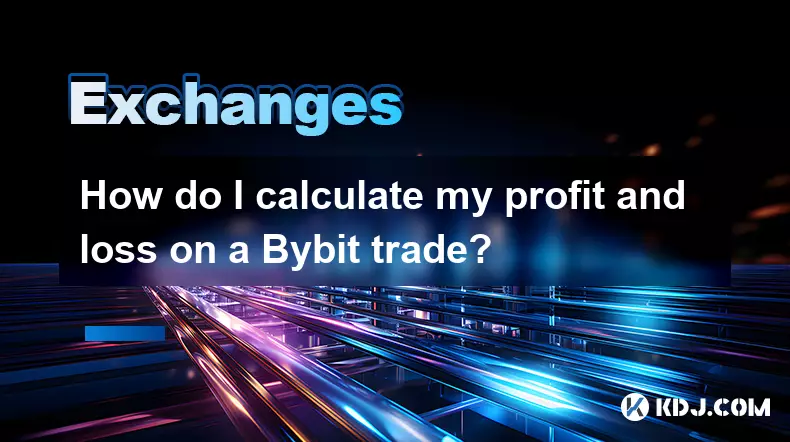-
 bitcoin
bitcoin $124586.364639 USD
0.62% -
 ethereum
ethereum $4670.671710 USD
3.33% -
 xrp
xrp $2.983701 USD
0.18% -
 tether
tether $1.000175 USD
-0.03% -
 bnb
bnb $1209.430642 USD
2.76% -
 solana
solana $231.365861 USD
0.51% -
 usd-coin
usd-coin $0.999665 USD
-0.02% -
 dogecoin
dogecoin $0.264657 USD
4.46% -
 tron
tron $0.346415 USD
1.60% -
 cardano
cardano $0.871586 USD
3.70% -
 chainlink
chainlink $23.451270 USD
7.56% -
 hyperliquid
hyperliquid $46.860071 USD
-2.96% -
 ethena-usde
ethena-usde $1.000120 USD
0.04% -
 sui
sui $3.611279 USD
1.08% -
 stellar
stellar $0.407149 USD
0.96%
How do I calculate my profit and loss on a Bybit trade?
Bybit's P&L calculation depends on trade type, with linear contracts settling in USDT and inverse contracts in crypto, while fees, funding, and leverage impact net gains or losses.
Sep 29, 2025 at 12:54 am

Understanding Profit and Loss on Bybit
Trading on Bybit involves precise calculations to assess performance. Traders must understand how gains and losses are determined based on entry and exit prices, position size, and fees. The platform supports both spot and derivatives trading, each with distinct P&L mechanics.
- For perpetual contracts, profit or loss is calculated using the difference between opening and closing prices, multiplied by the number of contracts.
- In inverse perpetual trades, P&L is settled in the base cryptocurrency, such as BTC or ETH, which introduces volatility from asset price changes.
- Linear perpetual contracts settle profits and losses in stablecoins like USDT, offering more predictable outcomes for traders focused on dollar-denominated results.
- Funding fees, paid periodically between long and short positions, also influence net profitability and must be factored into overall P&L.
- Liquidation events can result in total loss of margin if the market moves sharply against an open position without sufficient stop-loss protection.
Key Variables Affecting Trade Outcomes
Accurate P&L tracking requires awareness of several influencing factors beyond simple price movement. These variables shape the final return on any given trade.
- Entry and exit prices directly determine gross profit or loss before fees and funding costs are deducted.
- Leverage amplifies both gains and losses; a 10x leveraged position will see tenfold movement relative to the underlying asset’s price change.
- Trading fees—charged on both taker and maker orders—affect net returns, especially in high-frequency strategies where small margins are common.
- Market conditions such as slippage during volatile periods can lead to execution at less favorable prices than anticipated.
- Position size must align with account balance and risk tolerance to avoid disproportionate exposure that skews P&L interpretation.
Manual Calculation Methods for Different Trade Types
While Bybit provides built-in tools for tracking performance, knowing how to manually compute P&L enhances transparency and control over trading decisions.
- For a long position in a USDT-margined contract: (Exit Price – Entry Price) × Quantity = Profit in USDT.
- In an inverse futures contract: (1 / Entry Price – 1 / Exit Price) × Contracts × Contract Size gives BTC-denominated profit.
- Short positions reverse the order of prices in the formula: (Entry Price – Exit Price) × Quantity for linear contracts.
- Funding payments received or paid should be summed across the holding period and added or subtracted from total P&L.
- Net P&L equals gross profit minus opening and closing fees, applicable only when using taker orders or non-zero fee tiers.
Frequently Asked Questions
How does Bybit display unrealized versus realized P&L?Unrealized P&L appears in your position tab while a trade is active, reflecting current market value against entry. Realized P&L updates after closing a position, incorporating all fees and funding charges into the final result.
Can I export my trade history to calculate cumulative profits?Yes, Bybit allows users to download full trade histories in CSV format through the account dashboard. This data includes timestamps, prices, quantities, fees, and order types, enabling detailed spreadsheet-based analysis.
Does leverage affect the percentage return on a trade?Leverage increases the sensitivity of your margin to price movements. A 5% price move with 20x leverage yields a 100% margin gain or loss, but the actual profit in USD depends on position size and direction.
What happens to P&L when a position gets liquidated?Upon liquidation, the remaining margin is typically forfeited, resulting in a realized loss equal to the initial margin used. Insurance mechanisms may cover negative balances, but the position's P&L reflects a complete loss of capital allocated.
Disclaimer:info@kdj.com
The information provided is not trading advice. kdj.com does not assume any responsibility for any investments made based on the information provided in this article. Cryptocurrencies are highly volatile and it is highly recommended that you invest with caution after thorough research!
If you believe that the content used on this website infringes your copyright, please contact us immediately (info@kdj.com) and we will delete it promptly.
- BlockDAG, DOGE, HYPE Sponsorship: Crypto Trends Shaping 2025
- 2025-10-01 00:25:13
- Deutsche Börse and Circle: A StableCoin Adoption Powerhouse in Europe
- 2025-10-01 00:25:13
- BlockDAG's Presale Buzz: Is It the Crypto to Watch in October 2025?
- 2025-10-01 00:30:13
- Bitcoin, Crypto, and IQ: When Genius Meets Digital Gold?
- 2025-10-01 00:30:13
- Stablecoins, American Innovation, and Wallet Tokens: The Next Frontier
- 2025-10-01 00:35:12
- NBU, Coins, and Crypto in Ukraine: A New Yorker's Take
- 2025-10-01 00:45:14
Related knowledge

How to close my position in KuCoin Futures?
Oct 01,2025 at 07:54pm
Understanding Position Closure in KuCoin FuturesTrading futures on KuCoin requires a clear understanding of how to manage open positions. Closing a po...

How to find the contract address for a token on KuCoin?
Sep 30,2025 at 09:00pm
Finding the Contract Address on KuCoin1. Log into your KuCoin account through the official website or mobile application. Navigate to the 'Markets' se...

How to set up SMS verification on my KuCoin account?
Oct 03,2025 at 12:36am
How to Enable SMS Verification on Your KuCoin AccountSecuring your cryptocurrency exchange account is essential, especially on platforms like KuCoin w...

How to update the KuCoin app to the latest version?
Oct 03,2025 at 02:18am
How to Update the KuCoin App: A Step-by-Step GuideKeeping your KuCoin app updated ensures access to the latest security features, trading tools, and u...

How to buy an NFT on the KuCoin marketplace?
Oct 02,2025 at 10:19pm
Accessing the KuCoin NFT Marketplace1. Log in to your KuCoin account through the official website or mobile application. Ensure that two-factor authen...

How to create a sub-account on KuCoin?
Oct 03,2025 at 10:18pm
Accessing the KuCoin Dashboard1. Navigate to the official KuCoin website and log in using your registered email and password. Two-factor authenticatio...

How to close my position in KuCoin Futures?
Oct 01,2025 at 07:54pm
Understanding Position Closure in KuCoin FuturesTrading futures on KuCoin requires a clear understanding of how to manage open positions. Closing a po...

How to find the contract address for a token on KuCoin?
Sep 30,2025 at 09:00pm
Finding the Contract Address on KuCoin1. Log into your KuCoin account through the official website or mobile application. Navigate to the 'Markets' se...

How to set up SMS verification on my KuCoin account?
Oct 03,2025 at 12:36am
How to Enable SMS Verification on Your KuCoin AccountSecuring your cryptocurrency exchange account is essential, especially on platforms like KuCoin w...

How to update the KuCoin app to the latest version?
Oct 03,2025 at 02:18am
How to Update the KuCoin App: A Step-by-Step GuideKeeping your KuCoin app updated ensures access to the latest security features, trading tools, and u...

How to buy an NFT on the KuCoin marketplace?
Oct 02,2025 at 10:19pm
Accessing the KuCoin NFT Marketplace1. Log in to your KuCoin account through the official website or mobile application. Ensure that two-factor authen...

How to create a sub-account on KuCoin?
Oct 03,2025 at 10:18pm
Accessing the KuCoin Dashboard1. Navigate to the official KuCoin website and log in using your registered email and password. Two-factor authenticatio...
See all articles










































































